Abstract
OBJECTIVE: To evaluate the factors affecting the identification and accuracy of the sentinel node in breast cancer in a single institutional experience. SUMMARY BACKGROUND DATA: Few of the many published feasibility studies of lymphatic mapping for breast cancer have adequate numbers to assess in detail the factors affecting failed and falsely negative mapping procedures. METHODS: Five hundred consecutive sentinel lymph node biopsies were performed using isosulfan blue dye and technetium-labeled sulfur colloid. A planned conventional axillary dissection was performed in 104 cases. RESULTS: Sentinel nodes were identified in 458 of 492 (92%) evaluable cases. The mean number of sentinel nodes removed was 2.1. The sentinel node was successfully identified by blue dye in 80% (393/492), by isotope in 85% (419/492), and by the combination of blue dye and isotope in 93% (458/492) of patients. Success in locating the sentinel node was unrelated to tumor size, type, location, or multicentricity; the presence of lymphovascular invasion; histologic or nuclear grade; or a previous surgical biopsy. The false-negative rate of 10.6% (5/47) was calculated using only those 104 cases where a conventional axillary dissection was planned before surgery. CONCLUSIONS: Sentinel node biopsy in patients with early breast cancer is a safe and effective alternative to routine axillary dissection for patients with negative nodes. Because of a small but definite rate of false-negative results, this procedure is most valuable in patients with a low risk of axillary nodal metastases. Both blue dye and radioisotope should be used to maximize the yield and accuracy of successful localizations.
Full text
PDF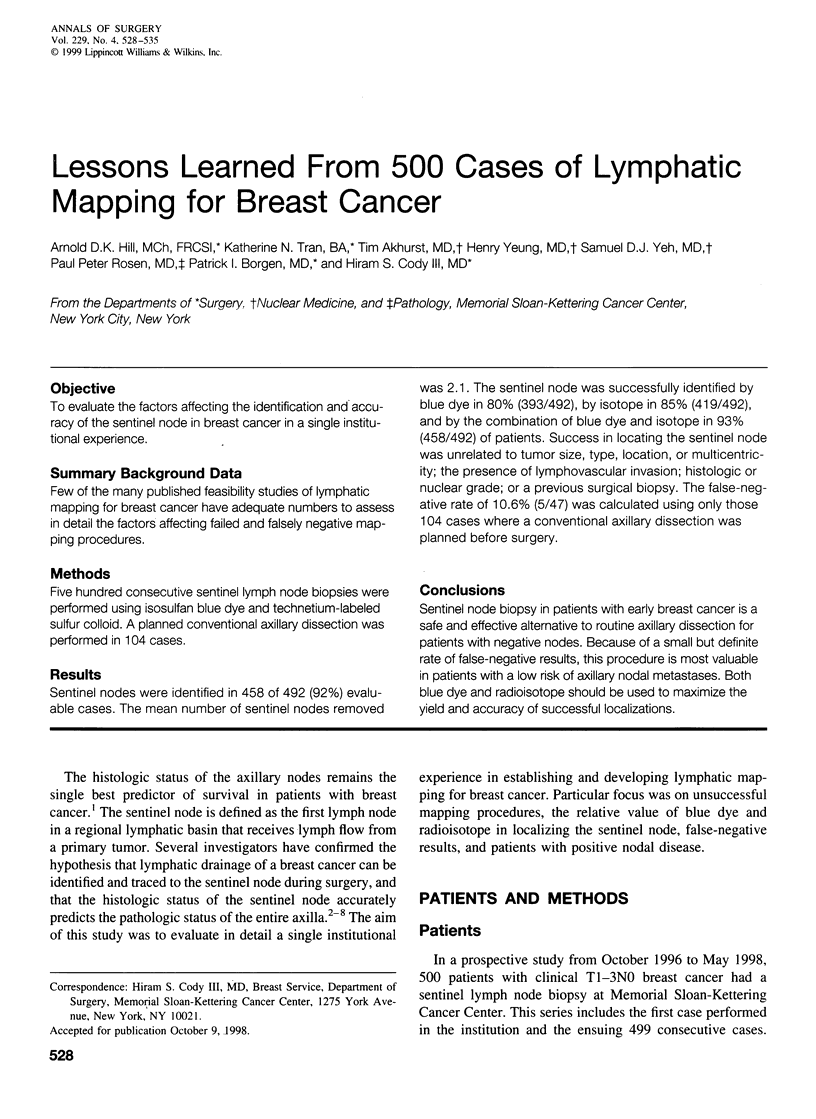
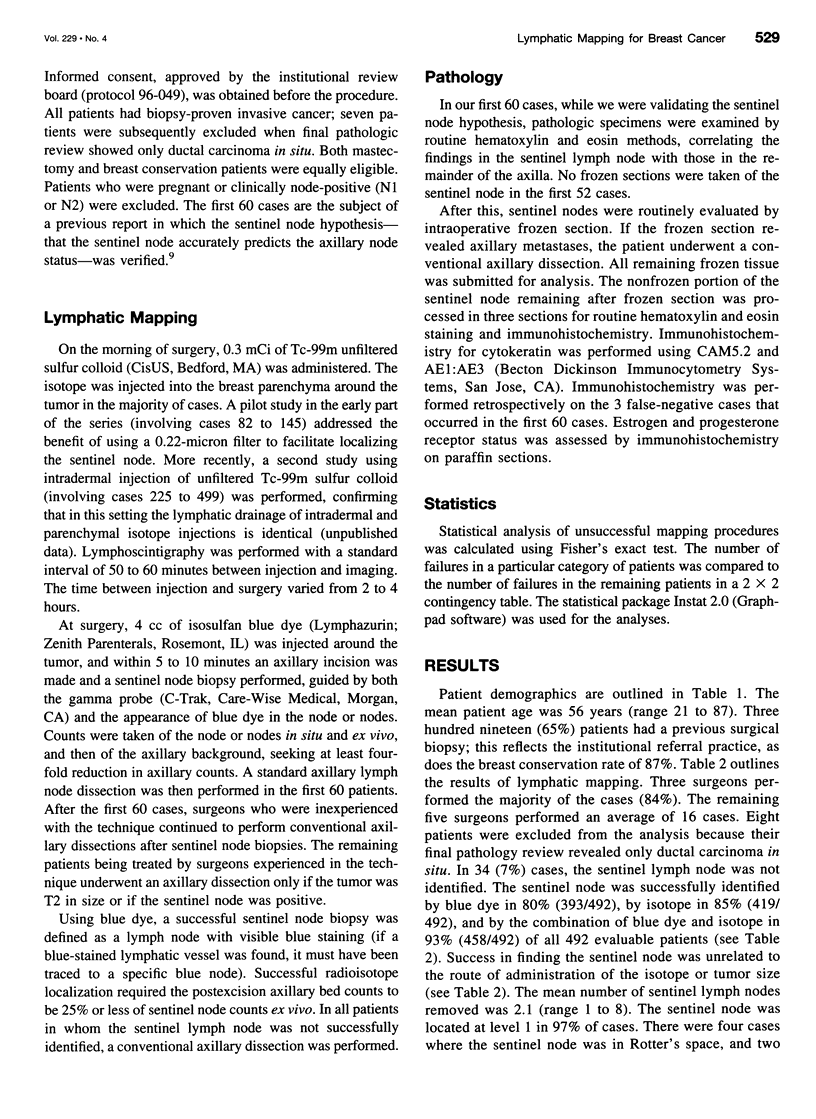
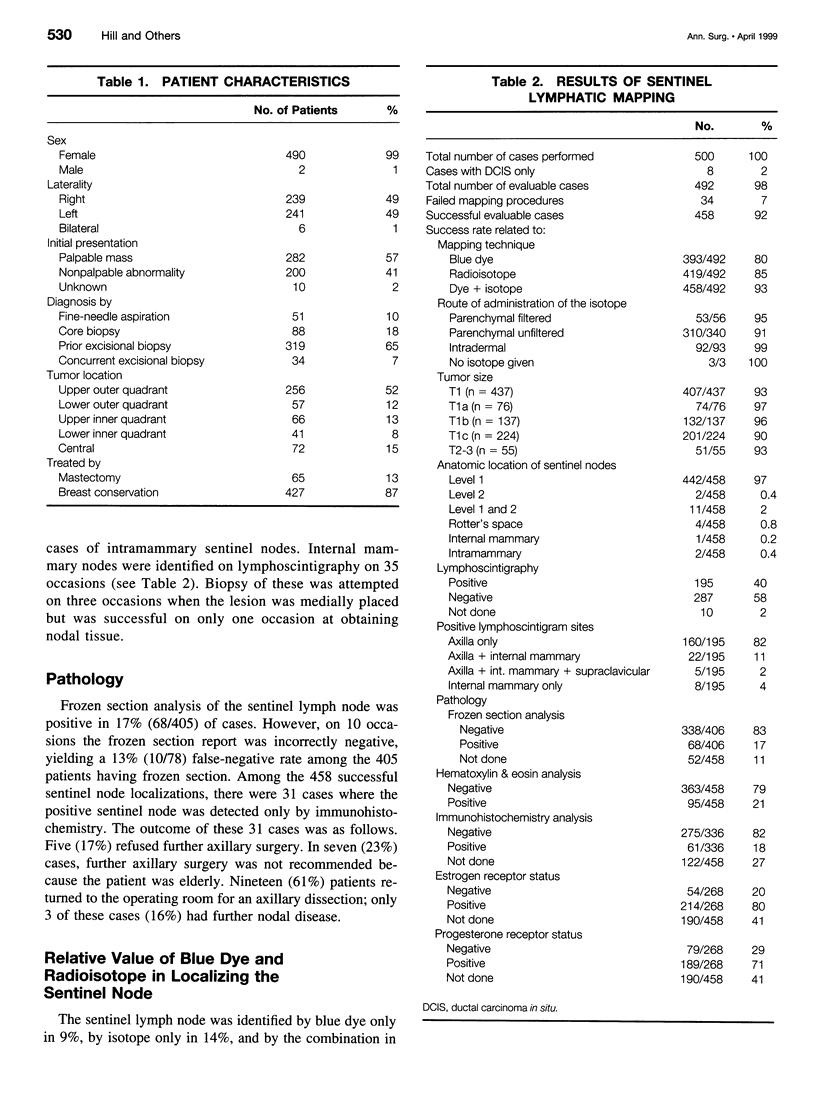

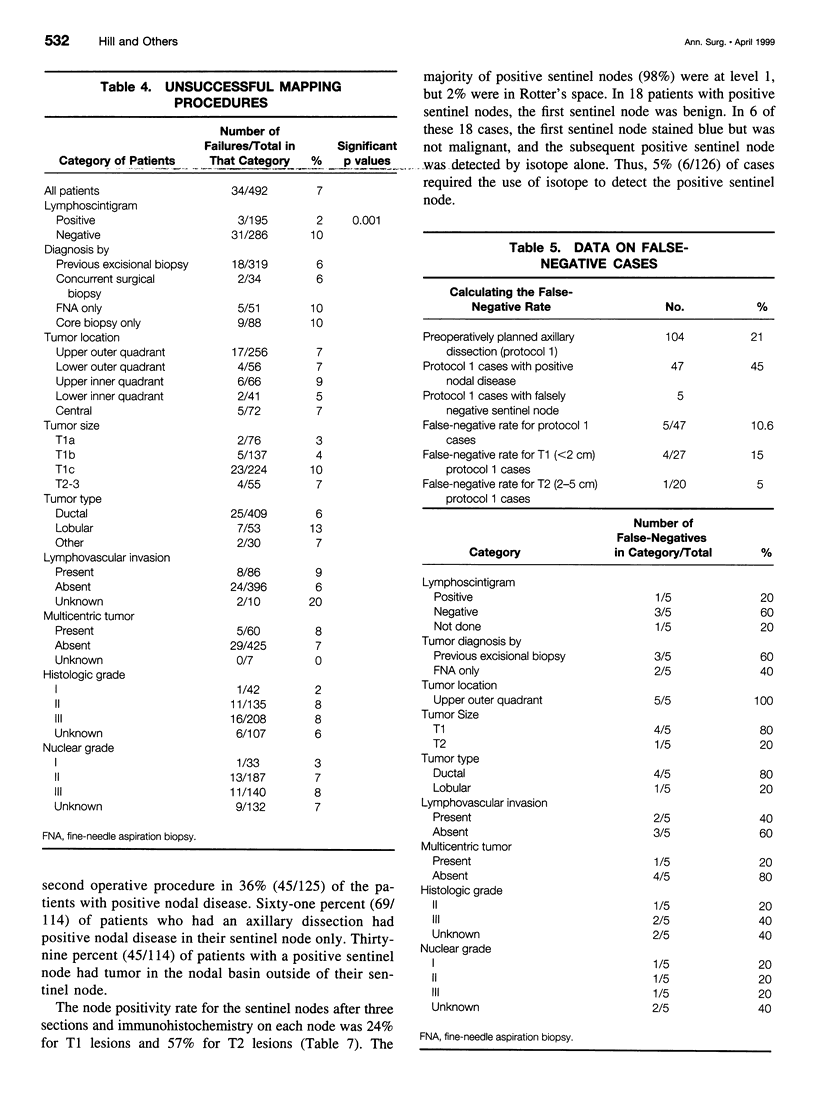

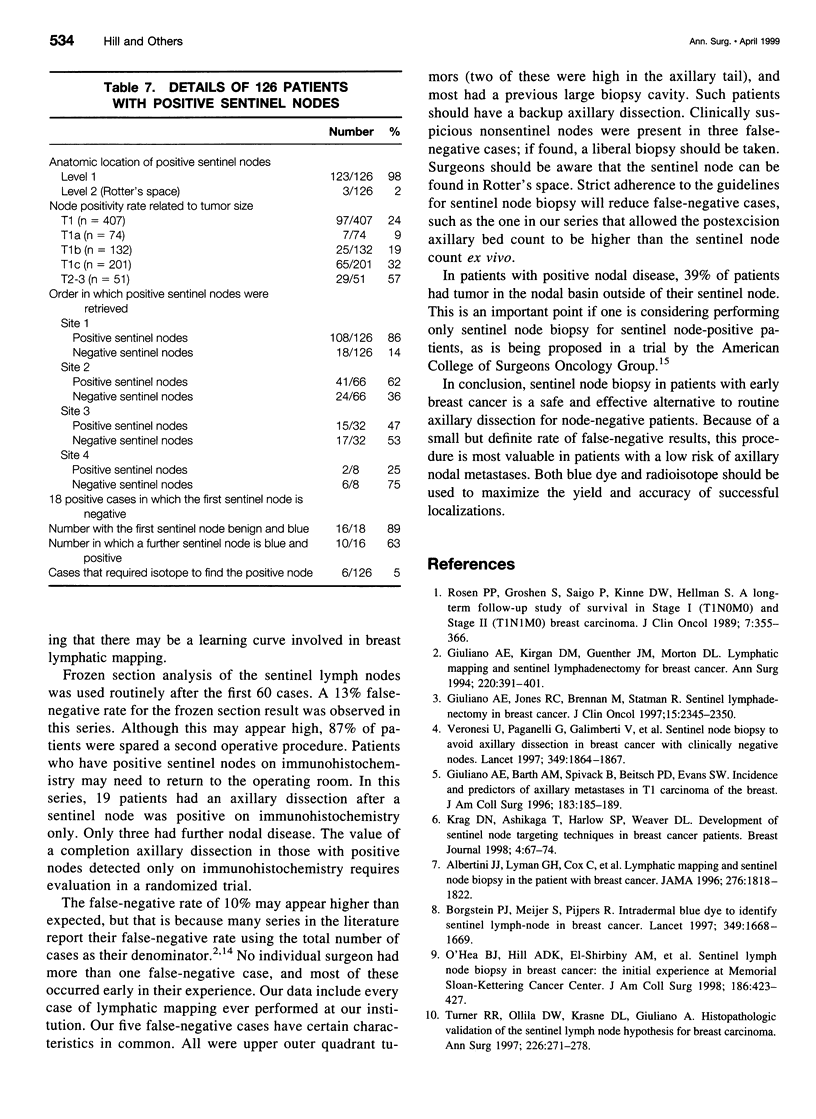

Selected References
These references are in PubMed. This may not be the complete list of references from this article.
- Albertini J. J., Lyman G. H., Cox C., Yeatman T., Balducci L., Ku N., Shivers S., Berman C., Wells K., Rapaport D. Lymphatic mapping and sentinel node biopsy in the patient with breast cancer. JAMA. 1996 Dec 11;276(22):1818–1822. [PubMed] [Google Scholar]
- Borgstein P. J., Meijer S., Pijpers R. Intradermal blue dye to identify sentinel lymph-node in breast cancer. Lancet. 1997 Jun 7;349(9066):1668–1669. doi: 10.1016/s0140-6736(05)62634-7. [DOI] [PubMed] [Google Scholar]
- Cox C. E., Pendas S., Cox J. M., Joseph E., Shons A. R., Yeatman T., Ku N. N., Lyman G. H., Berman C., Haddad F. Guidelines for sentinel node biopsy and lymphatic mapping of patients with breast cancer. Ann Surg. 1998 May;227(5):645–653. doi: 10.1097/00000658-199805000-00005. [DOI] [PMC free article] [PubMed] [Google Scholar]
- Giuliano A. E., Barth A. M., Spivack B., Beitsch P. D., Evans S. W. Incidence and predictors of axillary metastasis in T1 carcinoma of the breast. J Am Coll Surg. 1996 Sep;183(3):185–189. [PubMed] [Google Scholar]
- Giuliano A. E., Jones R. C., Brennan M., Statman R. Sentinel lymphadenectomy in breast cancer. J Clin Oncol. 1997 Jun;15(6):2345–2350. doi: 10.1200/JCO.1997.15.6.2345. [DOI] [PubMed] [Google Scholar]
- Giuliano A. E., Kirgan D. M., Guenther J. M., Morton D. L. Lymphatic mapping and sentinel lymphadenectomy for breast cancer. Ann Surg. 1994 Sep;220(3):391–401. doi: 10.1097/00000658-199409000-00015. [DOI] [PMC free article] [PubMed] [Google Scholar]
- Guenther J. M., Krishnamoorthy M., Tan L. R. Sentinel lymphadenectomy for breast cancer in a community managed care setting. Cancer J Sci Am. 1997 Nov-Dec;3(6):336–340. [PubMed] [Google Scholar]
- Nieweg O. E., Kapteijn B. A., Peterse J. L., Rutgers E. J., van Dongen J. A., Kroon B. B. Identificatie van de schildwachtklier bij patiënten met mammacarcinoom. Ned Tijdschr Geneeskd. 1996 Nov 9;140(45):2235–2239. [PubMed] [Google Scholar]
- O'Hea B. J., Hill A. D., El-Shirbiny A. M., Yeh S. D., Rosen P. P., Coit D. G., Borgen P. I., Cody H. S., 3rd Sentinel lymph node biopsy in breast cancer: initial experience at Memorial Sloan-Kettering Cancer Center. J Am Coll Surg. 1998 Apr;186(4):423–427. doi: 10.1016/s1072-7515(98)00060-x. [DOI] [PubMed] [Google Scholar]
- Rosen P. R., Groshen S., Saigo P. E., Kinne D. W., Hellman S. A long-term follow-up study of survival in stage I (T1N0M0) and stage II (T1N1M0) breast carcinoma. J Clin Oncol. 1989 Mar;7(3):355–366. doi: 10.1200/JCO.1989.7.3.355. [DOI] [PubMed] [Google Scholar]
- Turner R. R., Ollila D. W., Krasne D. L., Giuliano A. E. Histopathologic validation of the sentinel lymph node hypothesis for breast carcinoma. Ann Surg. 1997 Sep;226(3):271–278. doi: 10.1097/00000658-199709000-00006. [DOI] [PMC free article] [PubMed] [Google Scholar]
- Veronesi U., Paganelli G., Galimberti V., Viale G., Zurrida S., Bedoni M., Costa A., de Cicco C., Geraghty J. G., Luini A. Sentinel-node biopsy to avoid axillary dissection in breast cancer with clinically negative lymph-nodes. Lancet. 1997 Jun 28;349(9069):1864–1867. doi: 10.1016/S0140-6736(97)01004-0. [DOI] [PubMed] [Google Scholar]


